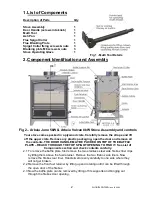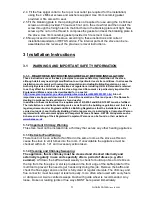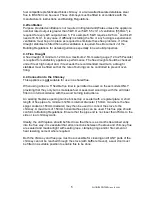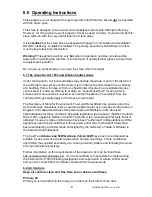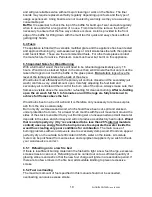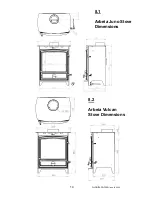
9
Juno & Vulcan
Issue 01 06/13
This provides a conventional air draught to the bed of the fire. The primary air intakes
need to be adjusted to give the best results when burning different fuels. It will usually
be closed when burning wood fuel and open when burning coal or smokeless type fuels.
Secondary Air (Air Wash)
Juno & Vulcan
stoves are provided with a sophisticated patented “air wash” system.
This secondary air supply to the stove is controlled through a slider assembly located on
the centre of the stove above the door. If you want clean glass, always leave this control
open some way whilst burning unless the stove is being shut right down for a long
period. The only time this control should be fully closed is for maximum efficiency on
Ancit fuel or for very slow burning on wood. The DEFRA air restrictor will deliberately
prevent full closure of this control.
Tertiary Air
This appliance is also fitted with a draught controlled tertiary air system that burns
otherwise uncombusted gasses in the products of combustion thereby improving
efficiency, increasing heat output and decreasing unwanted atmospheric emissions. The
Tertiary air supply to the stove is controlled entirely by the draught in the flue and
firebox. At certain stages of bur
ning you will notice “jets” of flame emerging near the air
holes to the rear of the firebox. For maximum efficiency on Ancit fuel the amount of
tertiary air is greatly reduced and so a seal is provided to be mounted inside the rear
airbox to restrict it for maximum efficiency. Remove the seal if the fuel is changed to
wood again.
Multifuel Grate
Your stove is fitted with a multifuel grate, which can be shaken from the right side of the
stove by inserting the pointed part of the multi tool into the knob and lifting up and down
or
pulling and pushing the knob depending on the model. The grate is a strong set of
cast iron bars with suitable air slots that assist the burning of most fuels. When burning
coal type fuels it is important to use the shaker grate and a poker where required to de-
ash regularly to ensure that the primary airflow is not impeded, as a build-up of ash
when burning coal
can damage the cast iron grate. A build up of wood ash when
burning wood will not harm the grate and indeed wood burns better on a bed of ash.
Excessive wood ash build up is not to be recommended however.
Ashpan
It is essential that you empty the ash pan regularly when burning coal type fuels. Use
the forked end of tool to lift the ash pan out of the stove. DO NOT allow coal ash to build
up underneath the bed as this may cause damage to the grate.
6.3 Cleaning
Glass:
Despite the advanced air wash system provided, the glass will still need cleaning
from time to time depending on the fuel quality and burning rates used. Never clean
glass when the stove is hot. Always use stove glass cleaner or ceramic hob cleaner,
which is available from your stove retailer. As an alternative, use a wet cloth with some
of the wood ash if burning wood but be very careful to use very clean ash so as not to
scratch the glass. DO NOT use coal ash to clean the glass.
Outer body:
The outer body simply needs to be dusted from time to time. DO NOT use
any kind of furniture polish or cleaning agent other then your stove suppliers
recommended paint.
Inner firebox:
Brush the inside of the firebox clean from time to time to check the
integrity of the plates and liners etc. It is not normally necessary to re-paint inside the
firebox due to the high temperatures that mean that the paint does not have much effect
before being burnt off. Steel and vermiculite board liners are resilient firebox materials



